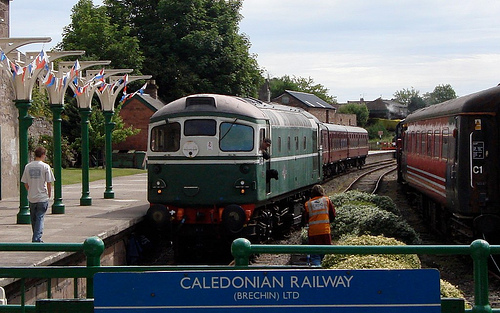Brechin
Brechin is located along the banks of the River South Esk in Angus. Although small, this was once classed as a city and the cathedral still looms large in the centre of town today. It is home to an impressive round tower dating from the 11th century, one of only two of its kind in mainland Scotland. This is a part of Scotland that was once home to the Picts, and visitors can learn more about these ancient people at Pictavia which is located in a beautiful countryside park in the grounds of Brechin Castle. Visitors here will also find a beautiful ornamental lake as well as in interactive nature trail and children’s adventure playground. Visit Brechin during the summer months and you will hear the distinctive sound of the Caledonian Steam Railway as it transports passengers from Brechin’s Victorian railway station to the Bridge of Dun.

Things to See and Do
The Caledonian Railway is a popular attraction with all members of the family. This wonderful heritage steam railway runs for four miles between Brechin and the Bridge of Dun. The line was built in 1848 and operates out of one of the most unique rail stations in the country. Aside from taking a trip along the line you will also be able to see a good selection of classic locomotives and their accompanying coaches as well as being able to pick up some unique souvenirs in the gift shop.
The Bridge of Dun was once a place where the royal trains used to stop and is close to one of the Scotland’s best bird sanctuaries. There are a number of walks to enjoy which start at the station and take you along the banks of the river. The Pictavia Visitor Centre is another popular attraction. Here you will learn about the Pictish people that once inhabited this part of the world during the first Millennium. Pictavia has won several awards and offers a unique insight into the lives of these ancient people.
The House of Dun
The House of Dun and its gardens are well worth a visit. The house is Georgian and boasts some incredible interior displays and the gardens and the woodland walk around the grounds are also very popular. The house itself overlooks the stunning Montrose Basin and was built in 1730 for the then Lord Dun, David Erskine and was designed by William Adam. There are many royal mementos within the house that have been collected over the years by the Erskine family, plus plenty of examples of contemporary plasterwork, embroidery and woodwork created by Lady Augusta Kennedy-Erskine. There is also a fine portraits collection and lots of antique porcelain and furniture. The courtyard is home to workshops where you can learn about weaving on a hand loom and there is also a miniature theatre display. The walled garden has undergone restoration and it has been replanted in true 1880’s style and there are platy of surprises to be found as you wander the rest of the gardens.


